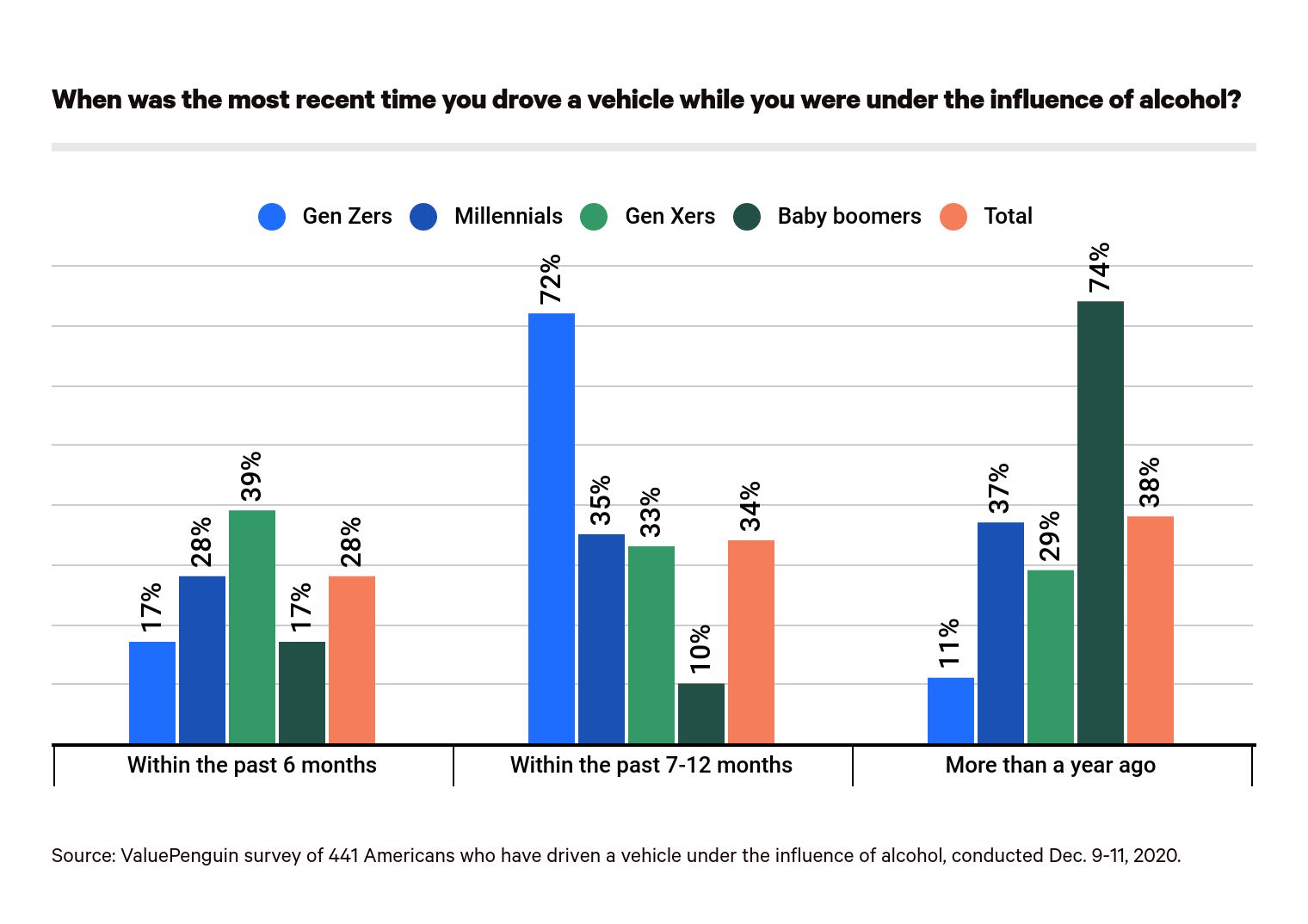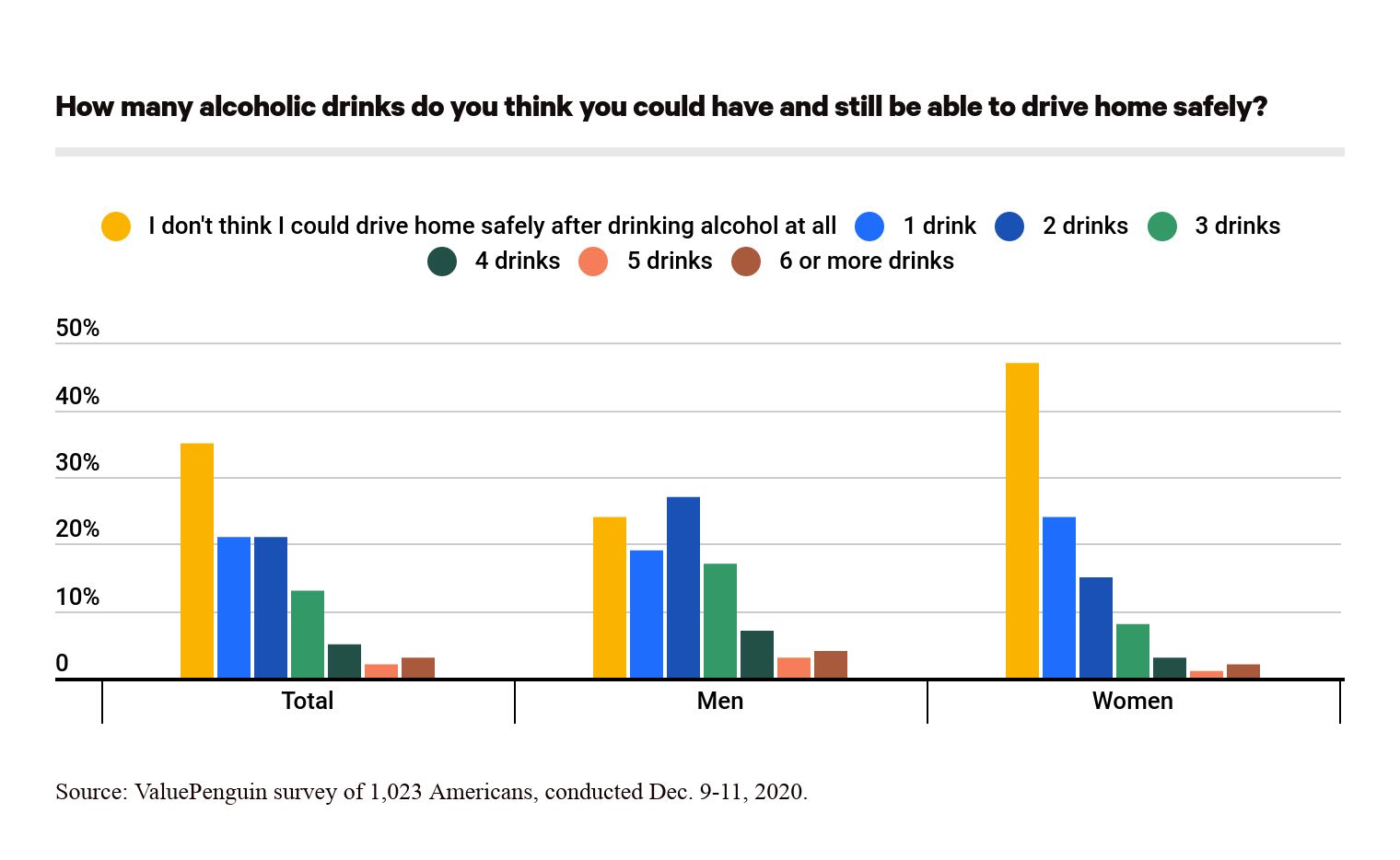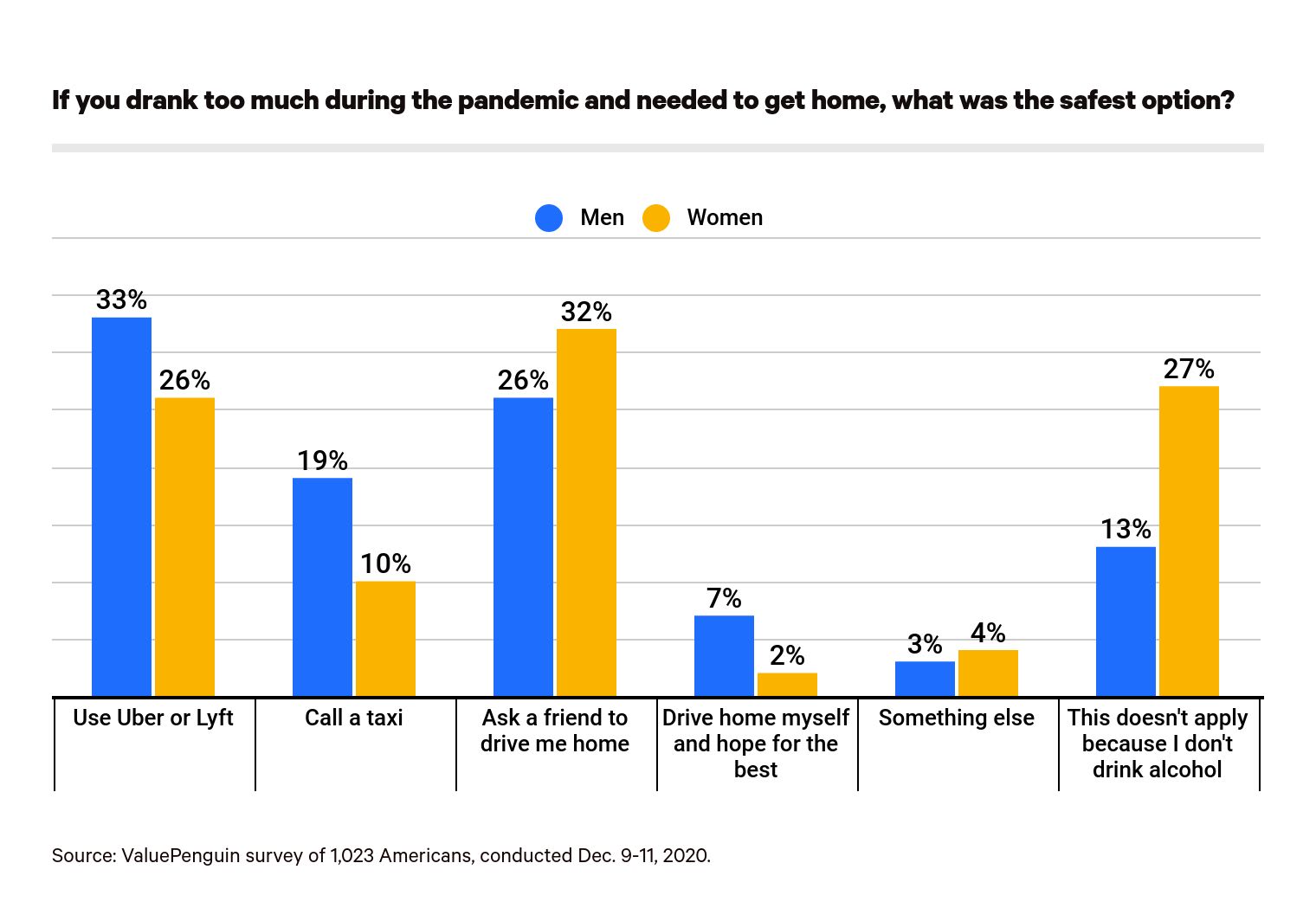Auto Insurance
43% of Americans — and 56% of Men — Admit to Drinking and Driving

More than 4 in 10 people admitted to getting behind the wheel after drinking, according to a recent ValuePenguin survey, while another 45% said they had gotten a ride from someone who had been drinking.
Thirty-seven percent said they drove after drinking because their destination was close. Nearly one-quarter said they didn't feel too intoxicated when they got behind the wheel. At the same time, more than 23% overestimated the amount of alcohol they could consume and still drive safely, according to guidelines from the Centers for Disease Control and Prevention (CDC).
Drivers caught drinking and driving are likely to suffer financial consequences. Forty-eight percent of those surveyed who admitted to drinking and driving were caught by the police. Moreover, 9 in 10 respondents who were caught drinking and driving attested to higher insurance premiums, court fees or other fines.
Key findings
- 43% of Americans admit to having driven under the influence of alcohol, and 45% have gotten a ride from someone who had been drinking. 56% of men admitted to drinking and driving, versus 29% of women.
- The main reason those surveyed say they drove after drinking — or rode with someone who had been drinking — is because they had to travel a short distance, or they didn’t think they (or the driver) were incapable of driving. Still, it’s a gamble, as nearly half (48%) of those who admitted to drinking and driving were pulled over by the police.
- Just under 1 in 4 overestimate the amount of alcohol they can drink and still drive safely. Nearly a third of men (31%) think they could safely drive after three drinks, which — for the average man — would put them over the legal limit.
- 44% of respondents believe their auto insurance would cover damage caused by an alcohol-impaired crash, but that may not be the case.
43% of people have driven after drinking, with 28% having done so in the past 6 months
While 43% of Americans admitted to driving under the influence of alcohol, men were far more likely than women to get behind the wheel after drinking. Twenty-nine percent of women said they’ve driven under the influence, but this percentage ballooned to 56% of men.
The likelihood of someone drinking and driving varies by generation, too. According to our survey, Gen Xers (57%) were most likely to have driven under the influence of alcohol, versus 47% of millennials and 27% of baby boomers. Despite the fact that many Gen Zers are under the legal drinking age, 44% admitted to driving under the influence — with 89% having done so in the past year.

When asked why they drove under the influence, people most commonly said they only had a short distance to go (37%). Another 24% said they didn't believe they were "that drunk" when they drove after drinking. While they may have considered using a rideshare app or taxi-hailing service, 16% opted to drive because they didn't feel safe in a taxi, Uber or Lyft, and 14% couldn't afford the expense.
What was the situation that led to your most recent instance of driving under the influence?
Reason | Percentage of respondents |
|---|---|
| I only had a short distance to drive | 37% |
| I didn't think I was that drunk | 24% |
| I didn’t feel safe in an Uber, Lyft or taxi | 16% |
| I couldn't afford an Uber, Lyft or taxi | 14% |
| I didn't want to worry about leaving my car overnight | 5% |
| Other reason | 5% |
Totals don't add up to 100% due to rounding.
While our findings show it’s common for people to drink and drive themselves, it's more likely that a person would get a ride from someone who had been drinking. Forty-five percent of those surveyed admitted they've gotten into a vehicle with someone who was under the influence, and 28% said they'd done so in the past six months.
Again, men (54%) were more likely than women (35%) to ride with someone who had been drinking. Fifty-nine percent of Gen Xers said they have hit the road with someone who'd been drinking, while 49% of millennials and 40% of Gen Zers reported the same.
As with people who'd driven themselves after drinking, about a third (30%) who'd gotten into cars with an intoxicated driver claimed to have done so because their destination was close. Also, 23% believed their companion wasn't "that drunk," and 13% had no other way to get home.
What was the situation that led to your most recent instance of getting a ride from someone under the influence?
Reason | Percentage of respondents |
|---|---|
| We only had a short distance to drive | 30% |
| I didn't think they were that drunk | 23% |
| I couldn't afford an Uber, Lyft or taxi | 13% |
| I had no other way to get home | 13% |
| I didn’t feel safe in an Uber, Lyft or taxi | 12% |
| I felt awkward speaking up about it | 7% |
| Other | 3% |
Totals don't add up to 100% due to rounding.
Nearly one-quarter of Americans — including 20% of Gen Zers — overestimate the amount they can drink and still drive safely
Whether someone was driving after drinking or they rode with an intoxicated person, ValuePenguin heard the refrain voiced by many Americans that they didn't believe they (or their companion) were "that drunk" when they got behind the wheel. Indeed, nearly a quarter of people overestimate the amount of alcohol they can drink and still drive safely.
According to the CDC, having just three drinks can lead to a deterioration of motor skills, including the ability to track moving objects and steer one's car. With this in mind, ValuePenguin's survey shows that 31% of men and 14% of women believe they could safely drive after three drinks.
People may be unable to drive after consuming fewer than three drinks. The CDC says impairment of visual and performance functions occurs after two drinks in many people.

Just 24% of men said they didn't think they could drive home safely after drinking any alcohol, compared with 47% of women. Moreover, 7% of men believe they can have four drinks and drive safely, while another 7% would be comfortable driving after five or more libations.
Generationally, Gen Xers were the most likely to overestimate the amount they can drink and still drive. Thirty-one percent think they could have three or more drinks and hit the road, while 29% of millennials and 20% of Gen Zers stated the same.
Fortunately, the opportunities for people to drink and drive may have diminished over the course of the pandemic. When asked about how the coronavirus pandemic has changed their alcohol intake, 24% said that most of their drinking takes place outside of the home. Before the pandemic, 36% said they most frequently drank alcohol away from home.
Where are you most likely to drink alcohol over the course of a typical month?
Location | Before the pandemic | During the pandemic |
|---|---|---|
| My house | 42% | 51% |
| A friend's house | 11% | 11% |
| A restaurant | 14% | 9% |
| A bar/brewery | 10% | 3% |
| Somewhere else | 1% | 1% |
| N/A, I don't drink alcohol | 22% | 25% |
Although many do drink and drive, more than 76% know driving after drinking isn't the best option during the pandemic — or ever
When asked about the safest way to get home after drinking during the pandemic, 58% of people viewed using a ridesharing app or asking a friend for a ride as the safest option. While 28% of people who drove after drinking did so in the past six months, only 5% said driving themselves home was the best option after going out to drink during the pandemic.
Women are more likely to seek a ride from friends than to hail a taxi or use a rideshare app after a night of drinking.

The majority of consumers know that drinking and driving isn't the safest option, but it's also a costly decision. Nearly half of people (48%) who admitted to drinking and driving were caught by the police. In fact, more than half of men (53%) who drove after drinking were stopped by the cops, while 40% of women had a run-in with the authorities.
Of those who were caught drinking and driving, 93% said they were hit financially by court fees, fines or higher insurance premiums afterward. ValuePenguin has calculated that the cost of insurance after a DUI can go up by 115% on average, which means thousands of dollars in some states.
If someone gets in a wreck from drinking and driving, they could encounter even greater costs. Forty-four percent of people think that auto insurance covers damage resulting from drunken driving, but this is only true for those who are injured by an intoxicated driver.
A driver’s collision coverage or personal injury protection (PIP) is supposed to pay for the damage they cause to their vehicle and themselves. But it's highly unlikely that an insurer would cover these kinds of damage if they were the result of someone driving under the influence. Far more often, the policyholder would have to pay for their own repairs themselves.
Methodology
ValuePenguin commissioned Qualtrics to conduct an online survey of 1,023 Americans, with the sample base proportioned to represent the overall population. The survey was fielded Dec. 9-11, 2020.
We defined generations as the following ages in 2020:
- Generation Z: 18 to 23
- Millennial: 24 to 39
- Generation X: 40 to 54
- Baby boomer: 55 to 74
The survey also included responses from the silent generation (ages 75 and older). However, their responses weren’t included in the generational breakdowns due to that age group’s low sample size.
